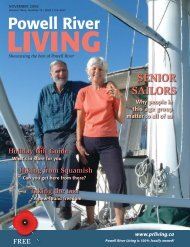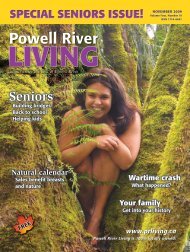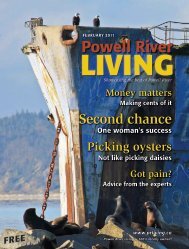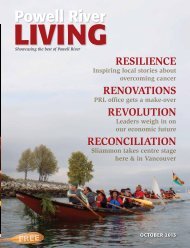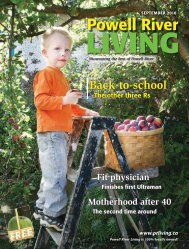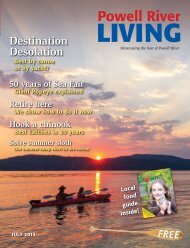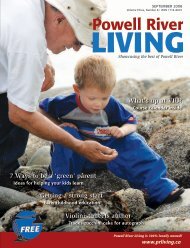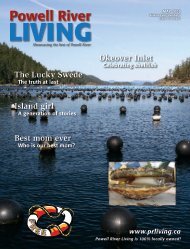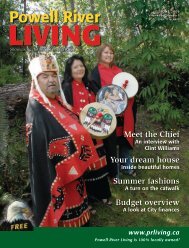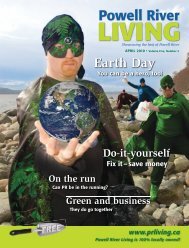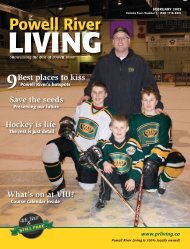Stunning Go for the green Real estate tips Healthy point of VIU
op for... - Powell River Living
op for... - Powell River Living
- No tags were found...
You also want an ePaper? Increase the reach of your titles
YUMPU automatically turns print PDFs into web optimized ePapers that Google loves.
Alien invasion<br />
Stopping invasive species a challenging job<br />
By Sean Percy<br />
To <strong>the</strong> untrained eye, <strong>the</strong> clump <strong>of</strong> bushes<br />
looks like just ano<strong>the</strong>r plant alongside<br />
upper Southview Road. But Blake<br />
Fougère recognizes it as <strong>the</strong> possible end<br />
<strong>of</strong> Powell River’s plant life as we know it.<br />
The alien invader is Japanese knotweed<br />
Fallopia japonica, an innocuous looking<br />
broad-leafed plant with bumps on <strong>the</strong><br />
stalks that give it <strong>the</strong> appearance <strong>of</strong> bamboo,<br />
though it is not closely related.<br />
Fougère, a pr<strong>of</strong>essional <strong>for</strong>ester and stewardship<br />
<strong>of</strong>ficer <strong>for</strong> <strong>the</strong> Ministry <strong>of</strong> Forests<br />
and Range, spotted a patch <strong>of</strong> <strong>the</strong> knotweed<br />
about 12 metres long by three metres<br />
deep growing alongside <strong>the</strong> road. Last<br />
month, with an excavator and a crew to<br />
spot any leftover chunks <strong>of</strong> root, <strong>the</strong> patch<br />
was dug up and buried deep in a nearby<br />
sand pit. The process cost about $1,000.<br />
Just up <strong>the</strong> road are several more patches.<br />
It will be more costly to remove <strong>the</strong>se because<br />
<strong>the</strong>re’s no convenient sand pit.<br />
But Fougère says something has to be<br />
done or <strong>the</strong> alien invader will take over<br />
and displace <strong>the</strong> native vegetation. In<br />
England, <strong>the</strong> plant has taken over vast areas<br />
and is now a banned substance.<br />
Fougère has also spotted patches <strong>of</strong> knotweed<br />
along Willingdon Creek. It’s particularly<br />
dangerous in riparian areas because it<br />
grows rapidly and spreads quickly as chunks<br />
What you can do<br />
• Start by not planting non-native species.<br />
• Learn to identify local invasive species in your area.<br />
• Remove <strong>the</strong>m if you have <strong>the</strong>m on your property.<br />
• Don’t dump gardening waste in <strong>the</strong> bush.<br />
• If you’re operating a grader, excavator or mower,<br />
make sure it’s properly cleaned be<strong>for</strong>e moving from<br />
one location to ano<strong>the</strong>r.<br />
<strong>of</strong> root break <strong>of</strong>f and float downstream, begetting<br />
new plants that displace native vegetation.<br />
Worst <strong>of</strong> all, it’s not a good stream<br />
bank stabilizer, leading to rapid erosion.<br />
ROOT CAUSE: The roots <strong>of</strong> Japanese<br />
knotweed break easily, and even a small<br />
fragment can grow a whole new plant.<br />
The knotweed has no natural predators<br />
or parasites in this part <strong>of</strong> <strong>the</strong> world to<br />
keep its rapid growth in check. The longterm<br />
solution is to find <strong>the</strong> right bug to<br />
introduce to control <strong>the</strong> weed, says Ernie<br />
Sellentin, <strong>the</strong> invasive alien plant technician<br />
with <strong>the</strong> ministry. But that takes years<br />
<strong>of</strong> research to ensure that it’s <strong>the</strong> right bug<br />
that doesn’t attack native plants and fur<strong>the</strong>r<br />
throw <strong>the</strong> ecosystem out <strong>of</strong> kilter.<br />
Eventually, says Sellentin, every species<br />
will turn up everywhere, but that<br />
may not be good <strong>for</strong> <strong>the</strong> planet, so he<br />
urges people not to plant species that<br />
could spread out <strong>of</strong> control.<br />
“If you plant something, it could be<br />
<strong>the</strong>re <strong>for</strong> <strong>the</strong> next 400 years. Who’s going<br />
to look after it when<br />
you’re gone?”<br />
Japanese knotweed is<br />
seen in a number <strong>of</strong> yards<br />
and gardens around Powell<br />
River. An unsuspecting<br />
gardener likely spread<br />
<strong>the</strong> Japanese knotweed<br />
by dumping clippings or<br />
roots alongside <strong>the</strong> road.<br />
Then it spread fur<strong>the</strong>r<br />
when a few bits <strong>of</strong> root got caught in <strong>the</strong><br />
blade <strong>of</strong> <strong>the</strong> road grader.<br />
Powell River’s infestation is small and<br />
might possibly be controlled. Along <strong>the</strong><br />
SPACE INVADER: Blake Fougère stands<br />
beside a clump <strong>of</strong> Japanese knotweed on<br />
Southview Road. The plant grows rapidly<br />
and displaces native vegetation.<br />
Cowichan River, however, it has shown up<br />
in 88 sites in a 30-kilometre stretch. It will<br />
take hundreds <strong>of</strong> thousands <strong>of</strong> dollars and<br />
heavy herbicide use to kill it. But if that’s<br />
not done soon, <strong>the</strong> size <strong>of</strong> <strong>the</strong> infestation<br />
and <strong>the</strong> cost to control it will double every<br />
five years, said Sellentin.<br />
But <strong>the</strong>re are success stories. At Carru<strong>the</strong>rs<br />
Road in Okeover, Fougère attacked<br />
a small infestation <strong>of</strong> giant hogweed, a<br />
particularly heinous alien containing phototoxic<br />
sap that can cause third degree<br />
burns on human skin.<br />
“We’re hoping we’ve eliminated that,”<br />
said Fougère.<br />
MOTORISTS<br />
Watch <strong>for</strong> Cyclists!<br />
CYCLISTS<br />
Be Aware. Be Safe.<br />
WEAR A HELMET<br />
Powell River<br />
Brain Injury Society<br />
4735 Marine Avenue<br />
Powell River, BC V8A 2L2<br />
604 485-6065<br />
info@ braininjurysociety.ca<br />
www.braininjurysociety.ca<br />
Powell River Living : april 2009 11



